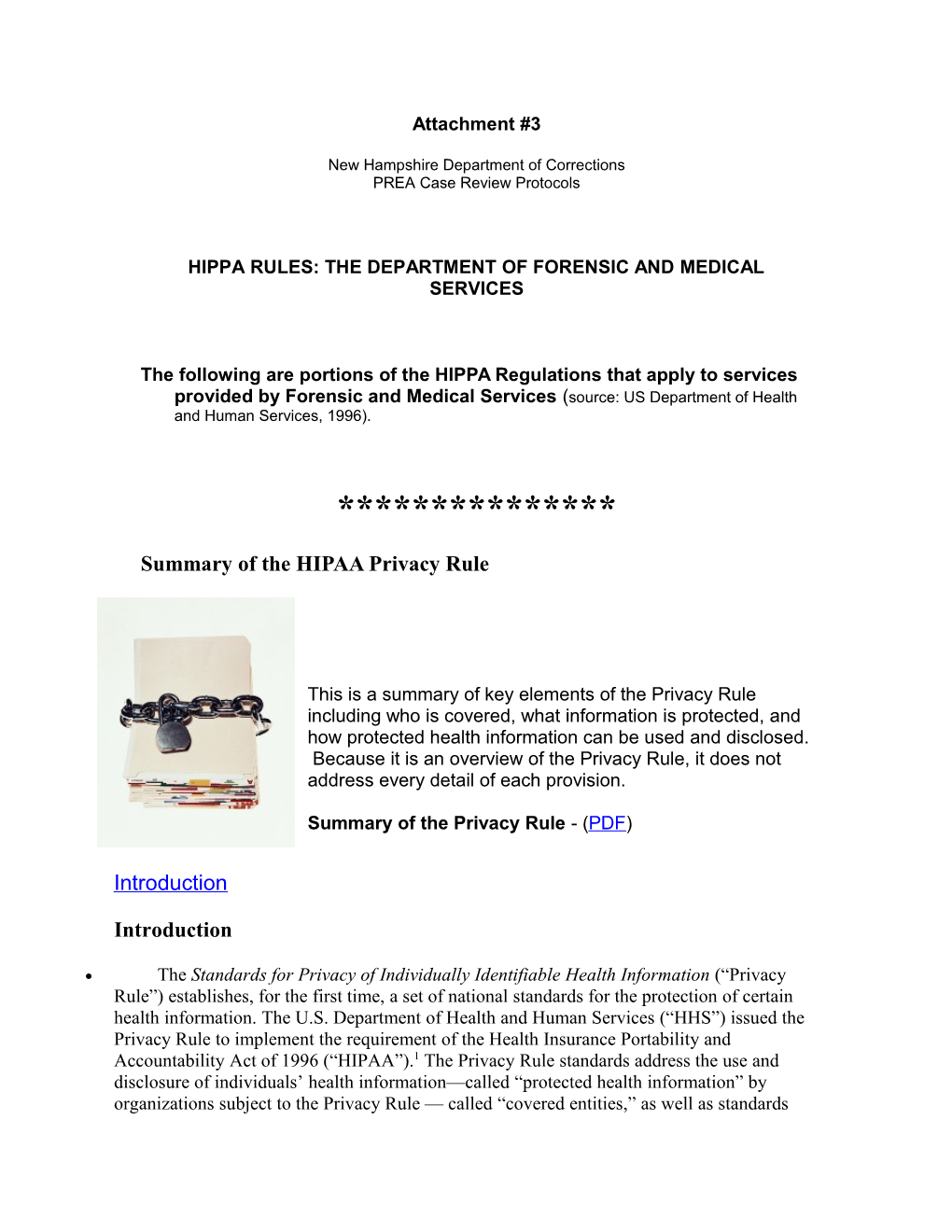Attachment #3
New Hampshire Department of Corrections
PREA Case Review Protocols
HIPPA RULES: THE DEPARTMENT OF FORENSIC AND MEDICAL SERVICES
The following are portions of the HIPPA Regulations that apply to services provided by Forensic and Medical Services (source: US Department of Health and Human Services, 1996).
***************
Summary of the HIPAA Privacy Rule
/This is a summary of key elements of the Privacy Rule including who is covered, what information is protected, and how protected health information can be used and disclosed. Because it is an overview of the Privacy Rule, it does not address every detail of each provision.
Summary of the Privacy Rule - (PDF)
Introduction
Introduction
- The Standards for Privacy of Individually Identifiable Health Information (“Privacy Rule”) establishes, for the first time, a set of national standards for the protection of certain health information. The U.S. Department of Health and Human Services (“HHS”) issued the Privacy Rule to implement the requirement of the Health Insurance Portability and Accountability Act of 1996 (“HIPAA”).1 The Privacy Rule standards address the use and disclosure of individuals’ health information—called “protected health information” by organizations subject to the Privacy Rule — called “covered entities,” as well as standards for individuals' privacy rights to understand and control how their health information is used. Within HHS, the Office for Civil Rights (“OCR”) has responsibility for implementing and enforcing the Privacy Rule with respect to voluntary compliance activities and civil money penalties.
A major goal of the Privacy Rule is to assure that individuals’ health information is properly protected while allowing the flow of health information needed to provide and promote high quality health care and to protect the public's health and well being. The Rule strikes a balance that permits important uses of information, while protecting the privacy of people who seek care and healing. Given that the health care marketplace is diverse, the Rule is designed to be flexible and comprehensive to cover the variety of uses and disclosures that need to be addressed.
This is a summary of key elements of the Privacy Rule and not a complete or comprehensive guide to compliance. Entities regulated by the Rule are obligated to comply with all of its applicable requirements and should not rely on this summary as a source of legal information or advice. To make it easier for entities to review the complete requirements of the Rule, provisions of the Rule referenced in this summary are cited in the end notes. Visit our Privacy Rule section to view the entire Rule, and for other additional helpful information about how the Rule applies. In the event of a conflict between this summary and the Rule, the Rule governs.
Statutory and Regulatory Background
Statutory and Regulatory Background
- The Health Insurance Portability and Accountability Act of 1996 (HIPAA), Public Law 104-191, was enacted on August 21, 1996. Sections 261 through 264 of HIPAA require the Secretary of HHS to publicize standards for the electronic exchange, privacy and security of health information. Collectively these are known as the Administrative Simplification provisions.
HIPAA required the Secretary to issue privacy regulations governing individually identifiable health information, if Congress did not enact privacy legislation within three years of the passage of HIPAA. Because Congress did not enact privacy legislation, HHS developed a proposed rule and released it for public comment on November 3, 1999. The Department received over 52,000 public comments. The final regulation, the Privacy Rule, was published December 28, 2000.2
Health Care Providers. Every health care provider, regardless of size, who electronically transmits health information in connection with certain transactions, is a covered entity. These transactions include claims, benefit eligibility inquiries, referral authorization requests, or other transactions for which HHS has established standards under the HIPAA Transactions Rule.6 Using electronic technology, such as email, does not mean a health care provider is a covered entity; the transmission must be in connection with a standard transaction. The Privacy Rule covers a health care provider whether it electronically transmits these transactions directly or uses a billing service or other third party to do so on its behalf. Health care providers include all “providers of services” (e.g., institutional providers such as hospitals) and “providers of medical or health services” (e.g., non-institutional providers such as physicians, dentists and other practitioners) as defined by Medicare, and any other person or organization that furnishes, bills, or is paid for health care.
